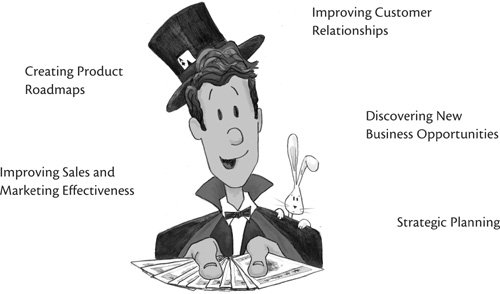Preface
| Innovation Games are fun ways to collaborate with your customers to better understand their needs. You can use them to discover new business opportunities, drive strategy and product road map decisions, improve the effectiveness of sales and service organizations, fine-tune marketing messages, and create more intimate, durable relationships with your customers. You can also use them to better understand the people that you care about the most, from your family and friends to close business colleagues. To illustrate, here are ways some companies and people have used Innovation Games: Understanding complex product relationships When Wyse Technologies, Inc. wanted to gain a better understanding of how their customers perceived the business and technical relationships between the products and services provided by Wyse and those provided by other technology providers, they played Spider Web with a select group of customers at their Customer Advisory Board meeting. Understanding product evolution Rally Software Development had a more focused objective: they wanted specific feedback on how to prioritize features in upcoming product releases. After considering Buy a Feature, 20/20 Vision, and Prune the Product Tree, three games that help prioritize features, they ultimately chose Prune the Product Tree as the game that allowed them to best capture customer feedback on their development plans. Figure 0.1. Innovation games can be used to accomplish many kinds of goals Understanding sales needs QUALCOMM used Product Box in an internal sales training exercise to identify critical customer success factors and relate these to product benefits. Another company, Ticketmaster, used Buy a Feature in an internal sales meeting to prioritize the features that the sales team felt would help them accomplish their objectives. Identifying areas for improvement Aladdin Knowledge Systems, Inc., QUALCOMM, and Precision Quality Software have all used Speed Boat to identify key areas for improvement in their product and service offerings. Prioritizing market needs Emerson Climate Technologies provides the Intelligent Store, a broad and comprehensive architecture that combines unique equipment, software, and services to solve food safety, energy management, and facilities management needs. Emerson used Spider Web, Speed Boat, and 20/20 Vision at their 2006 Technology Advisory Council meeting to better understand market needs relative to all aspects of the Intelligent Store. Understanding hidden desires Andre Gous's stepdaughter Karen was having trouble finding just the right used car. Andre runs Precision Quality Software and is a recognized expert on various software requirements engineering techniques. Andre tried using traditional requirements engineering to help her clarify her objectives. Unfortunately, after 45 minutes, they were no closer to the goal of defining her ideal car, and Karen was starting to become a little frustrated with the process. Andre tried Product Box, and in short order they had identified exactly what Karen was looking for in her "new" used car (you can read the entire story at the Innovation Games forum, www.innovationgames.com). Figure 0.2. With a little imagination, innovation games can be used in countless situations Creating strategic plans SDForum is the leading Silicon Valley not-for-profit organization providing an unbiased source of information and insight to the technology community for 20 years. Laura Merling, Executive Director of SDForum, used Remember the Future to create a five-year vision for how their organization will evolve to meet the needs of new technology entrepreneurs in Silicon Valley and around the world. These stories illustrate the broad range in which people like you, for professional and personal reasons, are using Innovation Games. You can use Innovation Games to accomplish these and other goals. If you use these games, you'll come to understand what your customers really want. You'll have fun doing it. Perhaps more importantly, they'll have fun doing it. Armed with this understanding, you'll be able to create the breakthrough innovative products that are the foundation of lasting success. This book will show you how. How This Book Is OrganizedThis book is organized into three parts. Part One: The Why and the How of Innovation GamesPart One provides a comprehensive overview of Innovation Games. Starting with why you might want to play them in the first place, it will cover some of the different ways in which you can use the games and answer some of the common questions we get from people who are considering the games. Part One describes an easy-to-use process for selecting, planning, playing, and postprocessing the results of a game in ways that benefit you and your customers. This process has been used successfully in many games. At the end of Part One you'll have the foundation you need to move forward with one or more specific games. Part Two: The GamesIn Part Two you'll learn the details about each game, from "what makes the game work" to specific advice on planning, playing, and postprocessing the results. It is helpful to start by briefly skimming each game, making notes on how you might apply it. You'll probably find that one or two games catch your eye more than the others. This is not an accident; these are the games most likely to help you address your most pressing concerns. Go back to these games and carefully read each one in detail. When you're finished, you should have a good understanding of how these games can meet your needs and how to modify the general process described in Part One to put them in action. Along the way, by reading about how other companies have used them, you'll gain insight and inspiration about how you can apply these games. Part Three: Tools and TemplatesPart Three is designed to help you use Innovation Games by providing you with a variety of tools and templates to plan, play, and process the results of a game. It includes such things as sample invitation letters, general materials and supply checklists, advice on preparing event venues and facilitating the games, and frequently asked questions. Forum for Readers, Game Players, and FacilitatorsIn addition to this book, the people who use Innovation Games have found creative ways to extend them and are sharing their experiences with others at www.innovationgames.com. I invite you to join this community, share your own experiences, and provide help and encouragement to others. Most of all, have fun with what follows. Luke Hohmann The ArtworkThe artwork for the games was created by Brent Rosenquist. Brent has worked with me for a number of years in a variety of roles: developer, user interface designer, and graphic artist, to name just a few. He worked with Rhett Guthrie to design the cover art for my first book, Journey of the Software Professional: A Sociology of Software Development. He is an exceptionally accomplished software developer, a great artist, and a wonderful friend. I hope you like the art as much as I do. The artwork used to describe how to play the games was created by Eliel Johnson. I met Eliel at the dcamp unconference, where he created one the most beautiful product boxes I've ever seen. I later learned that Eliel is an accomplished artist and user experience architect, with more than 10 years of experience working with Fortune 500 clients in the United States and Europe. He is a firm believer in a user-centered approach to design, and his passion about all aspects of innovation made him a natural choice to create the images you see in the book. You can learn more about Eliel at www.elieljohnson.com. Luke Hohmann |
EAN: 2147483647
Pages: 144

